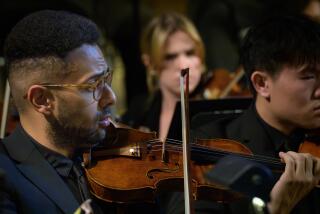SPANISH LUTE ENSEMBLE AT AMBASSADOR AUDITORIUM
- Share via
The Spanish Lute Orchestra “Grandio” is something of a misnomer, and an unfamiliar one at that. But with the promise of singers and dancers as well, it sufficed to sell out Ambassador Auditorium on Sunday afternoon.
“Grandio” simply refers to the orchestra’s founder, Roberto Grandio Rojo. The lutes, however, proved to be bandurrias, and one guitar. Double-strung and teardrop shaped like lutes, bandurrias are flat-backed like guitars and played with a plectrum like mandolins.
The orchestra’s uncredited arrangements of Spanish keyboard and guitar pieces, ancient and modern, often ranged far from the original. Percussion was added--effectively in Turina’s “Orgia,” obtrusively in Albeniz’s “Cordoba”--and the steady tremolo strumming produced incongruous effects in polyphonic music, such as a set of Diferencias by Cabezon.
Conductor J. R. Martinez Reyero, sporting a white scarf over his tails, led his 12 musicians with great attention to detail, eliciting rhythmically seductive playing, and a stunning dynamic range.
The orchestra’s delicate sound was easily dominated by its guests. Soprano Carmen Gonzalez and tenor Gonzalo Molina are attractive young singers with clear, ringing voices, and they overwhelmed the tremulous accompaniments--not originally for bandurrias-- in two zarzuela airs.
The sharply defined choreography of “Luisillo” (Luis Perez Davila) exploits the percussive potential of Spanish dance. The finger-snapping, thigh-slapping, and staccato heel work of Rocio Acosta and Francisco Morales buried the orchestra in the dance from Luna’s “Benamor.” Each projected supple strength in their solos--Acosta a leaping Fandango with castanets; Morales a bold, spinning Farruca.
Martinez’ own subdued Andalucian “Noctambulos” served the dancers better than the singers. Gonzalez proved a Micaela of great purity and power in an odd set of excerpts from “Carmen.”
More to Read
The biggest entertainment stories
Get our big stories about Hollywood, film, television, music, arts, culture and more right in your inbox as soon as they publish.
You may occasionally receive promotional content from the Los Angeles Times.










